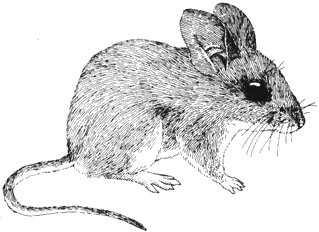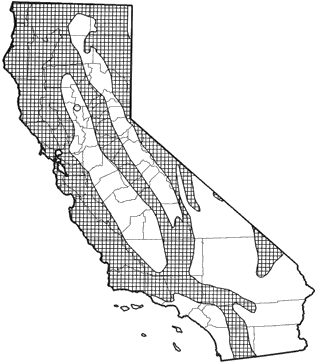
Pinon Mouse
Distribution, Abundance, and Seasonality
Found throughout California except in the Central Valley, most of the Mojave Desert, Owens Valley, and high-elevation regions of the Sierra Nevada. Occurs in most forested and shrub habitats in the state. Locally abundant in rocky areas with brushy thickets, or coniferous woodland with understory of mixed shrubs. Abundant in pinyon-juniper (Honeycutt et al. 1981) and ponderosa pine habitats. Elevational range from sea level to 2600 m (8600 ft).

Range Map
Specific Habitat Requirements
Feeding: Feeds primarily on leaves, seeds, arthropods, berries, fungi, and acorns (Merritt 1974). Peromyscus truei is an omnivore that forages on the ground surface, usually amidst underbrush, but also will climb small trees to forage. Sometimes caches food.
Cover: Seems to require some tree cover (Holbrook 1978) and/or brush thickets, rocks, logs, slash, litter.
Reproduction: Nests are constructed in hollow branches, trunks, logs, snags, or in rock crevices and at base of shrubs.
Water: May meet water needs from food or dew. Diet probably is influenced by water availability. Under lab conditions, drank 6 ml (0.2 oz) water/day (Merritt 1974).
Pattern: Pinyon-juniper or other open woodland, brushy and rocky areas, especially with ground cover.
Species Life History
Activity Patterns: Active year-round. Nocturnal.
Seasonal Movements / Migration: None.
Home Range: Home range in pinyon-juniper woodland in Colorado averaged 0.32 ha (0.79 ac), varying from 0.13-0.53 ha (0.32-1.30 ac) for males; averaged 0.25 ha (0.62 ac) for females, varying from 0.12-0.47 ha (0.31 -1.15 ac) (Douglas 1969). Merritt (1974) reported densities of 2.5/ha (1/ac) in oak-bay woodland and 86/ha (35/ac) in chaparral.
Territory: Territory restricted to vicinity of nest (McCabe and Blanchard 1950).
Reproduction: Breeds from April to November, with most preliminary records spanning May into September (Svihla 1932). Litter size averages 3 young (range 1-6). Average weaning age of 50 days (Clark 1938). Females may breed at 3 mo. of age (Layne 1968).
Niche: Considerable niche overlap with Peromyscus californicus, though in general P. truei is more specialized than P. californicus, in being more confined to "richer" chaparral (McCabe and Blanchard 1950). Predators include weasels, coyotes, owls, and feral cats.
Comments: Peromyscus truei is easily confused with P. californicus and P. boylii. It differs from P. boylii in that ear length is equal to, or greater than, hindfoot length (versus 70-80% of hindfoot length in P. boylii. P. truei is considerably smaller than P. californicus (Hoffmeister 1981).
Sources & References
California Department of Fish and Game, 1999.
California's Wildlife, Sacramento, CA.
Written by: P. Brylski, reviewed by: H. Shellhammer, edited by: R. Duke
Bradford, D. F. 1974. Water stress of free-living Peromyscus truei. Ecology 55:1407-1414. Clark, F. H. 1938. Age of sexual maturity in mice of the genus Peromyscus. J. Mammal. 19:230-234. Douglas, C. L. 1969. Comparative ecology of pinyon mice and deer mice in Mesa Verde National Park, Colorado. Univ. Kans. Publ., Mus. Nat. Hist. 18:421-504. Hoffmeister, D. F. 1981. Peromyscus truei. Mammal. Species No. 161. 5pp. Holbrook, S. J. 1978. Habitat relationships and coexistence of four sympatric species of Peromyscus in northwestern New Mexico. J. Mammal. 59:18-26. Honeycutt, R. L., M. P. Moulton, J. R. Roppe, and L. Fifield. 1981. The influence of topography and vegetation on the distribution of small mammals in southwestern Utah. Southwest. Nat. 26:295-300. Layne, J. N. 1968. Ontogeny. Pages 148-253 in J. A. King, ed. Biology of Peromyscus. Am. Soc. Mammal. Special Publ. No. 2. 593pp. McCabe, T. T., and B. D. Blanchard. 1950. Three species of Peromyscus. Rood Assoc., Santa Barbara, Ca. 136pp. Merritt, J. F. 1974. Factors influencing the local distribution of Peromyscus californicus in northern California. J. Mammal. 55:102-114. Svihla, A. 1932. A comparative life history study of the mice of the genus Peromyscus. Univ. Mich. Mus. Zool., Misc. Publ. No. 24. 39pp.
California Animal Facts | California's Wildlife